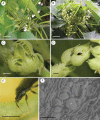A new pollination system: brood-site pollination by flower bugs in Macaranga (Euphorbiaceae)
- PMID: 18996950
- PMCID: PMC2707287
- DOI: 10.1093/aob/mcn212
A new pollination system: brood-site pollination by flower bugs in Macaranga (Euphorbiaceae)
Abstract
Background and aims: Macaranga (Euphorbiaceae) is a large genus of dioecious trees with approx. 260 species. To date, only one pollination study of the genus has reported brood-site pollination by thrips in M. hullettii. In this study, the pollination system of Macaranga tanarius is reported.
Methods: The study was conducted on Okinawa and Amami Islands, Japan. Flower visitors on M. tanarius were collected and their pollen load and behaviour on the flowers examined, as well as inflorescence structure and reward for the pollinators.
Key results: The most abundant flower visitors found on the male and female inflorescences were Orius atratus (Anthocoridae, Hemiptera), followed by Decomioides schneirlai (Miridae, Hemiptera). Pollen load on O. atratus from flowering pistillate inflorescences was detected as well as from staminate flowers. Orius atratus and D. schneirlai are likely to use the enclosed chambers formed by floral bracts as breeding sites before and during flower anthesis, and feed on nectar on the adaxial surface of flower bracts. The extrafloral nectary has a ball-shaped structure and the contained nectar is not exposed; the hemipterans pierce the ball to suck out the nectar.
Conclusions: The results indicate that the plant is pollinated by flower bugs breeding on the inflorescences. This study may be the first report of pollination systems in which flower bugs are the main pollinators. Similarity of pollination systems between M. hullettii and M. tanarius indicates that the two brood-site pollination systems have the same origin. The pollinator species belongs to a predacious group, whose major prey includes thrips. The pollination system might represent a unique example of evolution from predatory flower visitors feeding on the pollinators (thrips) to the main pollinators.
Figures


Similar articles
-
Thrips pollination of the dioecious ant plant Macaranga hullettii (Euphorbiaceae) in Southeast Asia.Am J Bot. 2002 Jan;89(1):50-9. doi: 10.3732/ajb.89.1.50. Am J Bot. 2002. PMID: 21669711
-
Modified leaves with disk-shaped nectaries of Macaranga sinensis (Euphorbiaceae) provide reward for pollinators.Am J Bot. 2013 Mar;100(3):628-32. doi: 10.3732/ajb.1200600. Epub 2013 Feb 27. Am J Bot. 2013. PMID: 23445826
-
Pollination biology in the dioecious orchid Catasetum uncatum: How does floral scent influence the behaviour of pollinators?Phytochemistry. 2015 Aug;116:149-161. doi: 10.1016/j.phytochem.2015.02.027. Epub 2015 Mar 11. Phytochemistry. 2015. PMID: 25771507
-
[The many ways flowers send signals to pollinators].Biol Aujourdhui. 2024;218(3-4):129-140. doi: 10.1051/jbio/2024013. Epub 2025 Jan 27. Biol Aujourdhui. 2024. PMID: 39868712 Review. French.
-
Mechanisms and evolution of deceptive pollination in orchids.Biol Rev Camb Philos Soc. 2006 May;81(2):219-35. doi: 10.1017/S1464793105006986. Biol Rev Camb Philos Soc. 2006. PMID: 16677433 Review.
Cited by
-
Diversification through multitrait evolution in a coevolving interaction.Proc Natl Acad Sci U S A. 2013 Jul 9;110(28):11487-92. doi: 10.1073/pnas.1307451110. Epub 2013 Jun 25. Proc Natl Acad Sci U S A. 2013. PMID: 23801764 Free PMC article.
-
Response of pollinator taxa to fire is consistent with historic fire regimes in the Sierra Nevada and mediated through floral richness†.Ecol Evol. 2023 Dec 14;13(12):e10761. doi: 10.1002/ece3.10761. eCollection 2023 Dec. Ecol Evol. 2023. PMID: 38107425 Free PMC article.
-
Plant-pollinator network structural properties differentially affect pollen transfer dynamics and pollination success.Oecologia. 2020 Apr;192(4):1037-1045. doi: 10.1007/s00442-020-04637-5. Epub 2020 Apr 9. Oecologia. 2020. PMID: 32274585
References
-
- Anderson B, Midgley JJ, Stewart BA. Facilitated selfing offers reproductive assurance: a mutualism between a hemipteran and a carnivorous plant. American Journal of Botany. 2003;90:1009–1015. - PubMed
-
- Armbruster WS. Exaptations link evolution of plant-herbivore and plant-pollinator interactions: a phylogenetic inquiry. Ecology. 1997;78:1661–1672.
-
- Cocucci AA, Vogel S. Oil-producing flowers of Sisyrinchium species (Iridaceae) and their pollinators in southern South America. Flora. 2001;196:26–46.
-
- Coll M, Guershon M. Omnivory in terrestrial arthropods: mixing plant and prey diets. Annual Review of Entomology. 2002;47:267–297. - PubMed
-
- Davies SJ, Lum SKY, Chan R, Wang LK. Evolution of myrmecophytism in western Malesian Macaranga (Euphorbiaceae) Evolution. 2001;55:1542–1559. - PubMed

